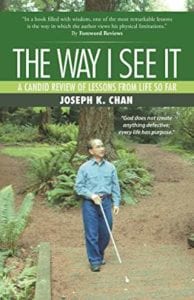
About the Book:
This book offers hope and inspiration to:
People who are visually impaired
People who have other bodily impairments
Parents who have a physically challenged child
People who ponder about the purpose of life
Born with not one, but two rather restrictive birth defects, Joseph Chan faced multiple challenges in coping as a little child. In addition to the stress of keeping up in school, the stigma of being different experienced in both his family and school was a burden in building self-esteem. These challenges permeates his life as a young adult. Trying to start a career in accounting and building a social life was a long and difficult learning process.
Despite a disadvantaged beginning, this is a story of love, faith, and personal triumph over fate. The Way I See It is Joseph Chan’s spiritual journey to discover his life’s purpose and to share the hope and inspiration that he has found with those who might also benefit from it.
Read an Excerpt:
Featured in April/May 2017 Issue: The Eighties
I was born with two rather restrictive birth defects. As soon as I was old enough to notice that I could not do some of the things other people could, I started asking why I had been given these obstacles. To have one of these defects was unfortunate; to carry the burden of two seemed very unfair. As a little child, I didn’t have an answer for myself. The family and the school system that I grew up in did not provide adequate support and guidance for children with special needs. I was only encouraged to “measure up” with my peers. That put a lot of stress on me. I worked hard to keep up, but no matter what I did, I was always below average in school, and the feeling of inferiority made me socially shy. After I graduated from college and stepped into the workplace, my low self-esteem was a stumbling block. It was difficult to convince people to look beyond my obvious handicaps. One person who noticed my real potential was a woman I met at a workplace. We got married and had thirteen wonderful years together. She gave me understanding, encouragement, and patience. But our relationship did not last as long as I wanted; her life was cut short by breast cancer. On the surface, this is a sad story, but one big lesson I have learned from this opera is that I am the one who decides whether it is a sad story or not. If I were to let the events in my life make me a sad person, then I would lose the chance to harvest all other fruits that can be realized. My story is one of perseverance, love, and personal triumph over fate. It is from pain and suffering I learned the most valuable lessons. This process not only has led to insights about the physical aspects of life but also has enticed me to develop my personal views of the spiritual purpose of human life, the question of God, and faith. I have learned that where I stand in these existential questions is the guiding light and sets the course for the remainder of my time on Earth.
